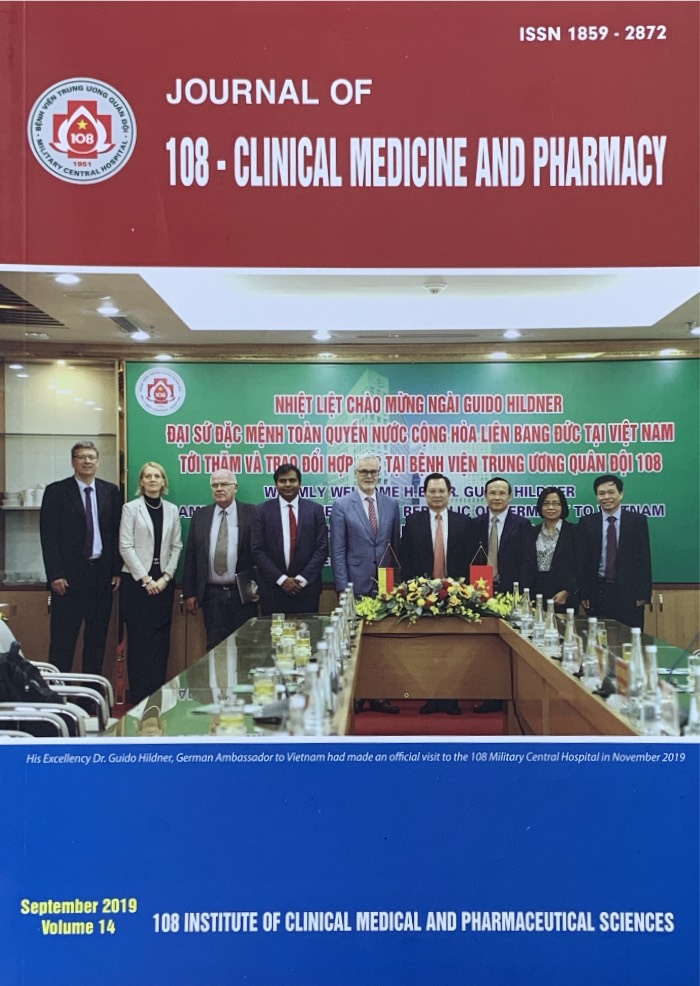Evaluation of orthodontic results of Angle Class I malocclusion with first premolar extraction
Main Article Content
Keywords
Tóm tắt
Objective: To evaluate the change of hard tissue and soft tissue after treatment of dental and skeletal bimaxillary protrusion in Angle Class I malocclusion patient by extraction of 4 premolars. Subject and method: The uncontrolled clinical trial of 45 patients with skeletal bimaxillary protrusion at Dental Department - 108 Military Central Hospital, from January of 2015 to May of 2018. Result and conclusion: Changes in hard tissue and soft tissue after treatment: Pre-treatment PAR index of malocclusion was 17.2 points, uneven anterior teeth has the highest index of 11.5; then uneven posterior teeth was 3.5. After treatment: Uneven anterior teeth, uneven posterior teeth, posterior teeth bite and overjet change were statistically significantly reduced (p<0.001), 88.2% of patients with PAR index decreased (> 70%); no patients with PAR changes < 40%. The protrusion of patient’s profile improved significantly after treatment. Angle of convexity changed -2.7 ± 1.460 with p<0.001 so that the surface reduced convexity. Reduce the protrusion of the upper and lower lip compared to the horizontal plane, respectively, those was 2.6 ± 2.41mm and 3.2 ± 2.81mm (p<0.001). The protrusion of the upper and lower lips compared to the esthetic line E after treatment was 0.8 ± 1.29mm and 3.0 ± 1.83mm, respectively, 2.3 ± 1.26mm and 3.2 ± 1.72 with p<0.001. The protrusion of upper lip and lower lip compared with SnPog’ plane after treatment was 7.4 ± 1.64mm and 7.0 ± 2.11mm respectively, decreased 2.0 ± 1.38 and 3.0 ± 1.89mm respectively. VAS score was 7.0 ± 1.05 points.
Article Details
Các tài liệu tham khảo
2. Proffit WR et al (1997) Prevalence of malocclusion and orthodontic treatment need in the United States: Estimates from the NHANES III survey. The International Journal of Adult Orthodontics and Orthognathic surgery 13(2): 97-106.
3. Bowman SJ, Johnston LE (2000) The esthetic impact of extraction and nonextraction treatments on caucasian patients. Angle Orthod 70(1): 3-10.
4. Lim HJ, Ko KT, Hwang HS (2008) Esthetic impact of premolar extraction and nonextraction treatments on Korean borderline patients. American Journal of Orthodontics and Dentofacial Orthopedics 133(4): 524-531.
5. Holdaway RA (1983) A soft-tissue cephalometric analysis and its use in orthodontic treatment planning. Part I. American Journal of Orthodontics 84(1): 1-28.
6. Young TM, Smith RJ (1993) Effects of orthodontics on the facial profile: A comparison of changes during nonextraction and four premolar extraction treatment. American Journal of Orthodontics and Dentofacial Orthopedics 103(5): 452-445.
7 Arnett GW, Bergman RT (1993) Facial keys to orthodontic diagnosis and treatment planning. Part I. American Journal of Orthodontics and Dentofacial Orthopedics 103(4): 299-312.
8. Verma SK et al (2012) Natural head position: Key position for radiographic and photographic analysis and research of craniofacial complex. Jounal of Oral Biology and Craniofacial Research 2(1): 46-49.
 ISSN: 1859 - 2872
ISSN: 1859 - 2872
